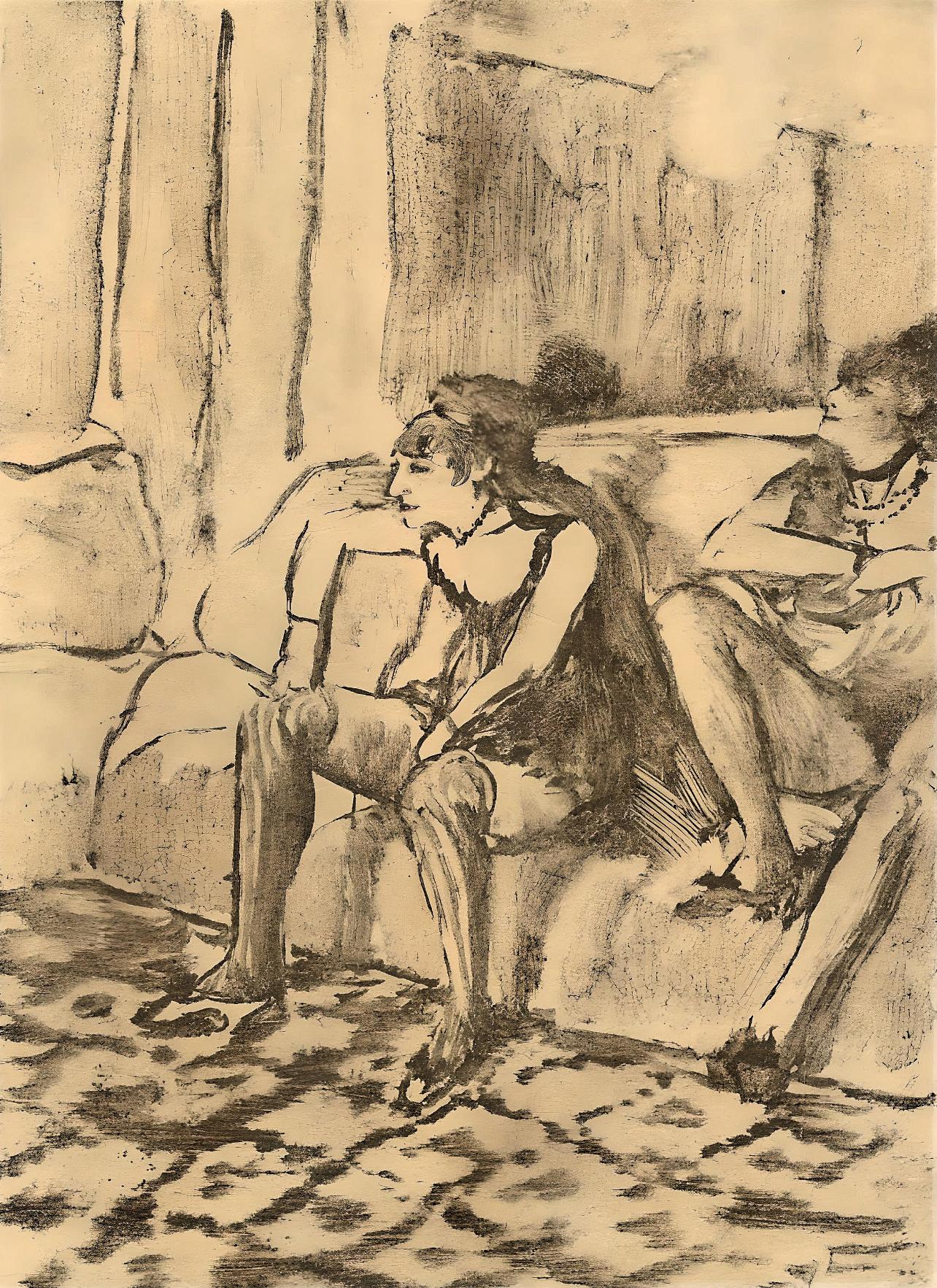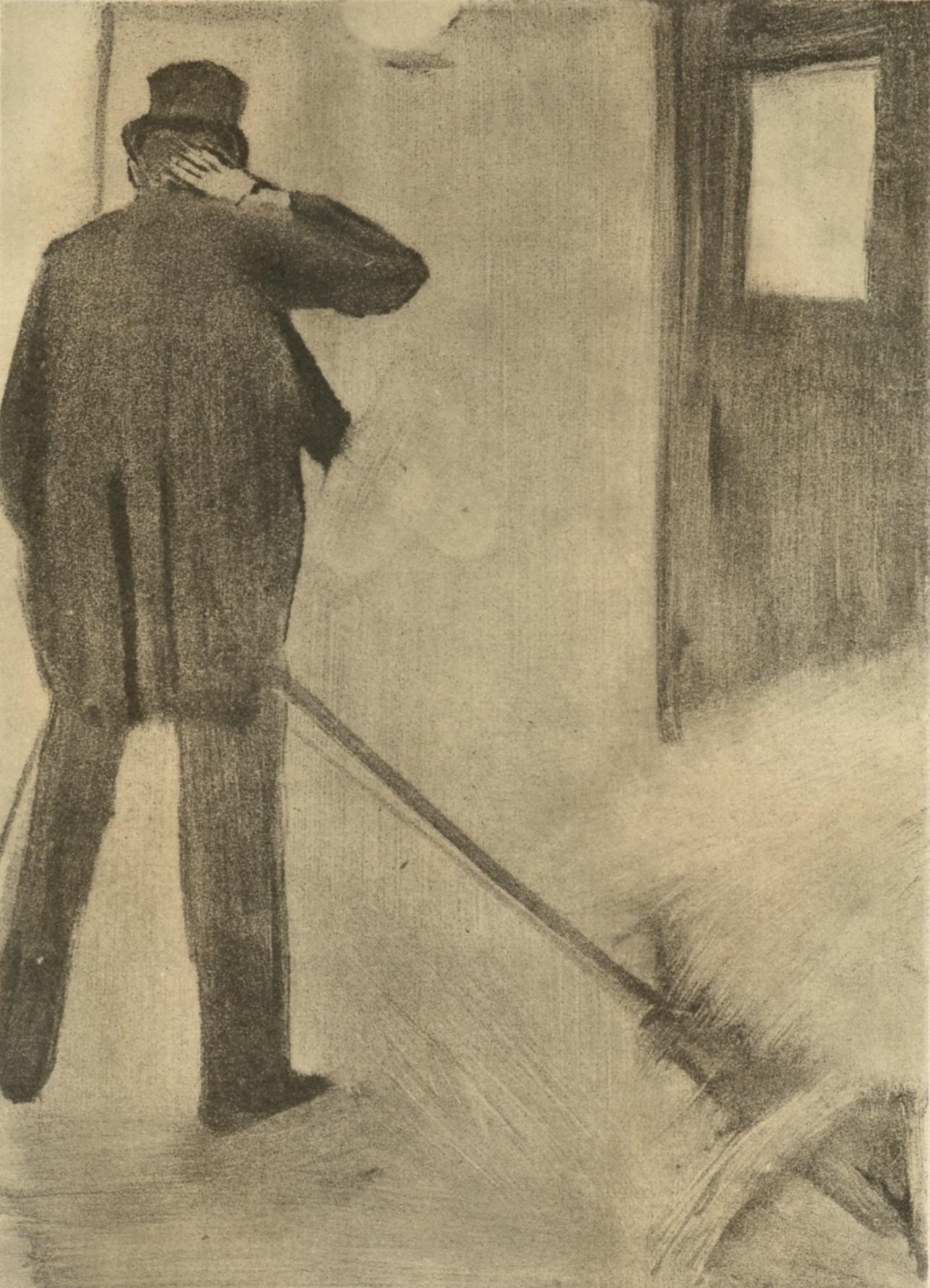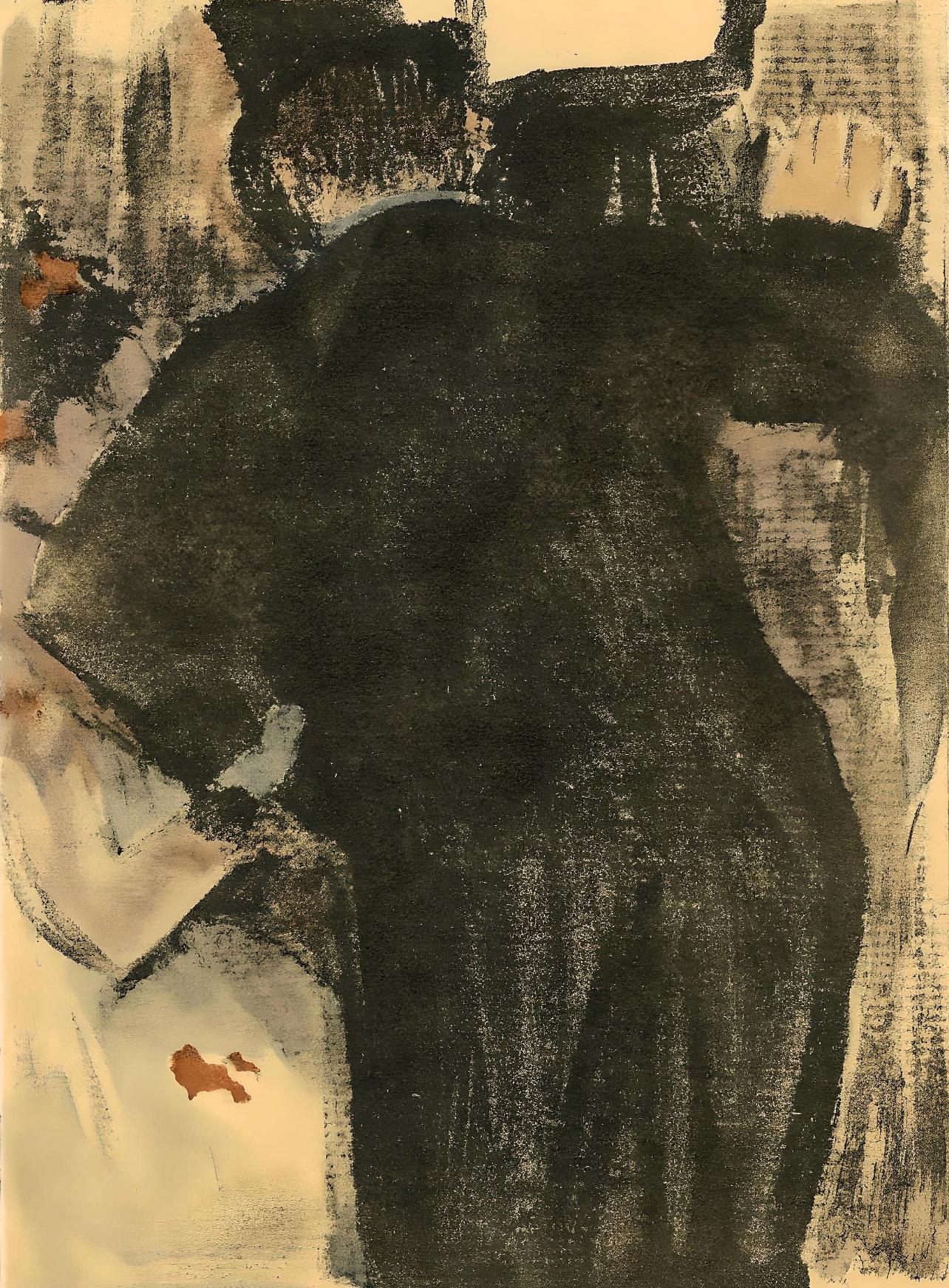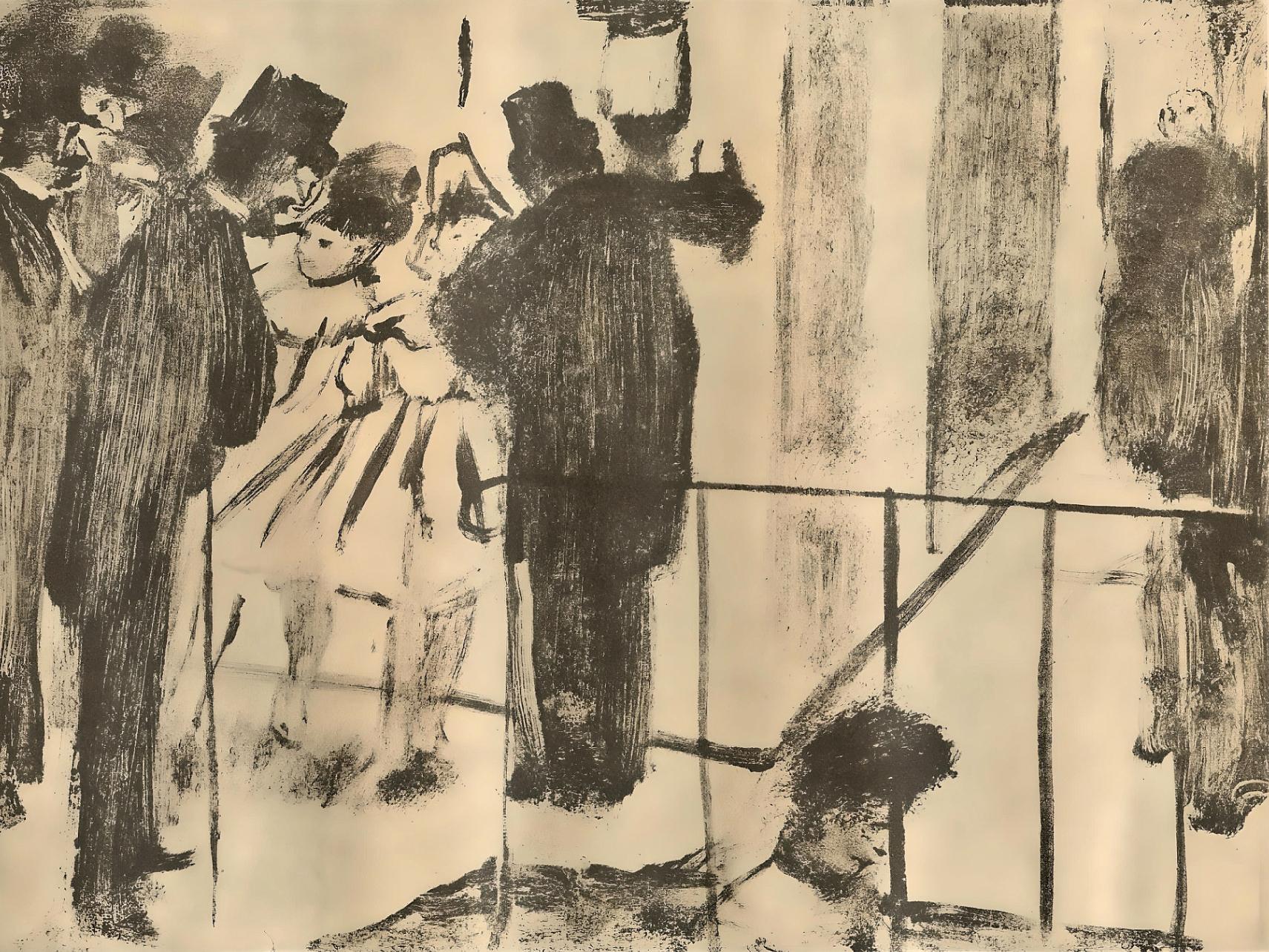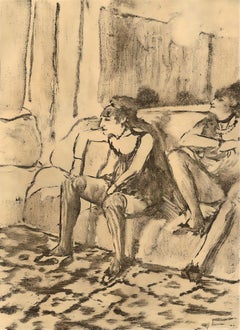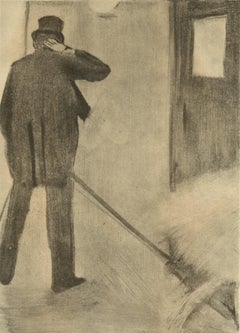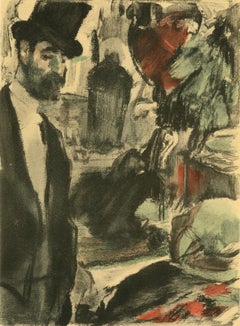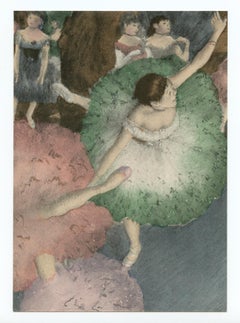Items Similar to Degas, Deux hommes en pied, Les Réalistes Lyriques (after)
Want more images or videos?
Request additional images or videos from the seller
1 of 12
Degas, Deux hommes en pied, Les Réalistes Lyriques (after)1973
1973
$716
$89520% Off
£547.43
£684.2820% Off
€627.21
€784.0120% Off
CA$1,009.92
CA$1,262.4020% Off
A$1,099.55
A$1,374.4420% Off
CHF 587.12
CHF 733.9020% Off
MX$13,273.27
MX$16,591.5920% Off
NOK 7,381.20
NOK 9,226.5020% Off
SEK 6,865.37
SEK 8,581.7220% Off
DKK 4,684.93
DKK 5,856.1620% Off
About the Item
Medium: Lithograph on vélin d'Arches paper
Year: 1973
Paper Size: 26 x 20 inches
Inscription: Unsigned and unnumbered, as issued
Notes: From the folio, Les Réalistes Lyriques, VIII, Collection Pierre Levy, 1973; published by Fernand Mourlot, Paris; printed by Mourlot Frères, Paris, November 23, 1973. Excerpted from the folio, This album, the eighth in a series dedicated to Mr. Pierre Lévy's collection, was printed in M examples on Arches vélin. Printing was completed on November 23, 1973 by Mourlot for reproductions of the paintings of the Les Réalistes Lyriques and by Fequet and Baudier for typography. Fernand Mourlot, Paris 1973.
EDGAR DEGAS (1834-1917) was a French Impressionist artist famous for his pastel drawings and oil paintings. Degas also produced bronze sculptures, prints, and drawings. Degas is especially identified with the subject of dance; more than half of his works depict dancers. Although Degas is regarded as one of the founders of Impressionism, he rejected the term, preferring to be called a realist, and did not paint outdoors as many Impressionists did. Degas was a superb draftsman, and particularly masterly in depicting movement, as can be seen in his rendition of dancers and bathing female nudes. In addition to ballet dancers and bathing women, Degas painted racehorses and racing jockeys, as well as portraits. His portraits are notable for their psychological complexity and their portrayal of human isolation. At the beginning of his career, Degas wanted to be a history painter, a calling for which he was well prepared by his rigorous academic training and close study of classical Western art. In his early thirties he changed course, and by bringing the traditional methods of a history painter to bear on contemporary subject matter, he became a classical painter of modern life. Generations of artists, including Picasso, have been influenced by Degas.
- Creation Year:1973
- Dimensions:Height: 26 in (66.04 cm)Width: 20 in (50.8 cm)
- Medium:
- Movement & Style:
- After:Edgar Degas (1834-1917, French)
- Period:
- Condition:
- Gallery Location:Fairfield, CT
- Reference Number:1stDibs: LU1342116197352
About the Seller
4.8
Vetted Professional Seller
Every seller passes strict standards for authenticity and reliability
Established in 2002
1stDibs seller since 2020
916 sales on 1stDibs
Typical response time: 1 hour
- ShippingRetrieving quote...Shipping from: Fairfield, CT
- Return Policy
More From This Seller
View AllDegas, Deux Femmes, E. Degas Monotypes (after)
By Edgar Degas
Located in Fairfield, CT
Medium: Engraving on vélin du Marais paper
Year: 1948
Paper Size: 12.25 x 9.125 inches; image size: 6.5 x 4.75 inches
Inscription: Unsigned and unnumbered, as issued
Notes: From the ...
Category
1940s Impressionist Figurative Prints
Materials
Engraving
$956 Sale Price
20% Off
Degas, Famille Cardinal, E. Degas Monotypes (after)
By Edgar Degas
Located in Fairfield, CT
Medium: Engraving on vélin du Marais paper
Year: 1948
Paper Size: 12.25 x 9.125 inches; image size: 6.24 x 4.75 inches
Inscription: Unsigned and unnumbered, as issued
Notes: From the...
Category
1940s Impressionist Figurative Prints
Materials
Engraving
$956 Sale Price
20% Off
Degas, Famille Cardinal, E. Degas Monotypes (after)
By Edgar Degas
Located in Fairfield, CT
Medium: Engraving on vélin du Marais paper
Year: 1948
Paper Size: 12.25 x 9.125 inches; image size: 8.5 x 6.75 inches
Inscription: Unsigned and unnumbered, as issued
Notes: From the ...
Category
1940s Impressionist Figurative Prints
Materials
Engraving
$716 Sale Price
20% Off
Degas, Famille Cardinal, E. Degas Monotypes (after)
By Edgar Degas
Located in Fairfield, CT
Medium: Engraving on vélin du Marais paper
Year: 1948
Paper Size: 12.25 x 9.125 inches; image size 6.24 x 4.75 inches
Inscription: Unsigned and unnumbered, as issued
Notes: From the ...
Category
1940s Impressionist Figurative Prints
Materials
Engraving
$956 Sale Price
20% Off
Degas, Un Client serieux, E. Degas Monotypes (after)
By Edgar Degas
Located in Fairfield, CT
Medium: Engraving on vélin du Marais paper
Year: 1948
Paper Size: 12.25 x 9.125 inches; image size 8.5 x 6.375 inches
Inscription: Unsigned and unnumbered, as issued
Notes: From the ...
Category
1940s Impressionist Figurative Prints
Materials
Engraving
$716 Sale Price
20% Off
Degas, Famille Cardinal, E. Degas Monotypes (after)
By Edgar Degas
Located in Fairfield, CT
Medium: Engraving on vélin du Marais paper
Year: 1948
Paper Size: 12.25 x 9.125 inches; image size: 6.375 x 8.5 inches
Inscription: Unsigned and unnumbered, as issued
Notes: From the...
Category
1940s Impressionist Figurative Prints
Materials
Engraving
$956 Sale Price
20% Off
You May Also Like
Mimes des Courtisanes de Lucien: one plate - Twins
By (after) Edgar Degas
Located in Paris, IDF
Edgar DEGAS (after)
Reproduction of a monotype as published in the first edition of "Mimes des Courtisanes de Lucien / Dialogue of the Courtesans by Lucien" trans. Pierre Louys, 1934...
Category
1930s Modern Figurative Prints
Materials
Etching, Aquatint
pochoir
By (after) Edgar Degas
Located in Henderson, NV
Medium: pochoir (after the drawing). A soft and delicate impression, printed in Paris in 1948 and published in an edition of 1200 by Braun et Cie. Size: 6 1/2 x 4 1/2 inches (164 x 1...
Category
1940s Impressionist Portrait Prints
Materials
Lithograph, Stencil
Mimes des Courtisanes de Lucien: one plate
By (after) Edgar Degas
Located in Paris, IDF
Edgar DEGAS (after)
Reproduction of the monotype "Au Salon" (In the Salon) as published in the first edition of "Mimes des Courtisanes de Lucien" by Pierre Louys, 1934/35.
Etching an...
Category
1930s Modern Figurative Prints
Materials
Etching, Aquatint
pochoir
By (after) Edgar Degas
Located in Henderson, NV
Medium: pochoir (after the pastel). A soft and delicate impression, printed in Paris in 1948 and published in an edition of 1200 by Braun et Cie. Size: 6 1/2 x 4 1/2 inches (164 x 11...
Category
1940s Impressionist Portrait Prints
Materials
Lithograph, Stencil
pochoir
By (after) Edgar Degas
Located in Henderson, NV
Medium: pochoir (after the painting). A soft and delicate impression, printed in Paris in 1948 and published in an edition of 1200 by Braun et Cie. Size: 6 1/2 x 4 1/2 inches (164 x ...
Category
1940s Impressionist Portrait Prints
Materials
Lithograph, Stencil
Deux vieillards aux chatons - Impressionist Figurative Oil by J F Raffaelli
By Jean-Francois Raffaelli
Located in Marlow, Buckinghamshire
Signed figures in interior oil on panel by French impressionist painter Jean-Francois Raffaelli. The piece depicts two old men seated in an interior. One is reading his paper as the other naps and there are several kittens on the floor. Painted in the artist's distinctive style.
Signature:
Signed lower left
Dimensions:
Framed: 9.5"x8"
Unframed: 5.5"x4"
Provenance:
Brame & Lorenceau have confirmed the authenticity of this work and it will be included in the digital catalogue raisonne of the painter which is under preparation
A certificate of authenticity fromBrame & Lorenceau accompanies this painting
Private collection - United States
Original artists label verso
Jean-François Raffaëlli's father was a failed Italian businessman and Raffaëlli himself was, among other things, a church chorister, actor and theatre singer. He then studied under Gérôme at the École des Beaux-Arts in Paris. He travelled to Italy, Spain and Algeria and on his return to France settled in Asnières.
In 1876, on a trip to Brittany, he first saw the potential of realist subject matter, if treated seriously. He became involved in meetings of artists at the Café Guerbois, where the Impressionist painters used to gather. As a result, Degas, contrary to the advice of the group, introduced Raffaëlli to the Impressionist exhibitions - according to one uncertain source as early as the very first exhibition, at the home of Nadar, and certainly to those of 1880 and 1881.
In 1904, Raffaëlli founded the Society for Original Colour Engraving. He first exhibited at the Salon de Paris in 1870 and continued to exhibit there until he joined the Salon des Artistes Français in 1881, where he earned a commendation in 1885, was made Chevalier of the Légion d'Honneur in 1889 and in the same year was awarded a gold medal at the Exposition Universelle. In 1906 he was made Officier of the Légion d'Honneur. He was also a member of the Société Nationale des Beaux-Arts. In 1884, a private exhibition of his work cemented his reputation.
He contributed to several newspapers such as The Black Cat (Le Chat Noir) in 1885 and The French Mail (Le Courrier Français) in 1886 and 1887. He published a collection entitled Parisian Characters, which captured his favourite themes of the street, the neighbourhood and local people going about their lives. In 1880 he participated, with Forain, on the illustration of Joris Karl Huysmans' Parisian Sketches (Croquis Parisiens). He also illustrated Huysman's Works. As well as working as an illustrator, he also made etchings and coloured dry-points.
His early attempts at painting were genre scenes, but once he was settled in Asnières he started to paint picturesque views of Parisian suburbs. From 1879 onwards, his subject matter drew on the lives of local people. These popular themes, which he treated with humanity and a social conscience, brought him to the attention of the social realist writers of the time such as Émile Zola. In addition to his realist style, Raffaëlli's dark palette, which ran contrary to the Impressionist aesthethic, helped to explain the opposition of those painters to his participation in their exhibitions. More concerned with drawing than colour, he used black and white for most of his paintings. Towards the end of his life, he lightened his palette, but without adopting any other principles of the Impressionist technique.
After painting several portraits, including Edmond de Goncourt and Georges Clémenceau, he returned to genre painting, particularly scenes of bourgeois life. Later in his career, he painted mainly Breton-inspired sailors and views of Venice. His views of the Paris slums and the fortifications, sites which have almost completely disappeared, went some way towards establishing a genre in themselves and perpetuated the memory of the area: The Slums, Rag-and-Bone Man, Vagabond, Sandpit, In St-Denis, Area of Fortifications. His realistic and witty portrayal of typical Parisian townscapes accounts for his enduring appeal.
Born in Paris, he was of Tuscan descent through his paternal grandparents. He showed an interest in music and theatre before becoming a painter in 1870. One of his landscape paintings was accepted for exhibition at the Salon in that same year. In October 1871 he began three months of study under Jean-Léon Gérôme at the École des Beaux-Arts in Paris; he had no other formal training.
Raffaëlli produced primarily costume pictures until 1876, when he began to depict the people of his time—particularly peasants, workers, and ragpickers seen in the suburbs of Paris—in a realistic style. His new work was championed by influential critics such as J.-K. Huysmans, as well as by Edgar Degas.
The ragpicker became for Raffaëlli a symbol of the alienation of the individual in modern society. Art historian Barbara S. Fields has written of Raffaëlli's interest in the positivist philosophy of Hippolyte-Adolphe Taine, which led him to articulate a theory of realism that he christened caractérisme. He hoped to set himself apart from those unthinking, so-called realist artists whose art provided the viewer with only a literal depiction of nature. His careful observation of man in his milieu paralleled the anti-aesthetic, anti-romantic approach of the literary Naturalists, such as Zola and Huysmans.
Degas invited Raffaëlli to participate in the Impressionist exhibitions of 1880 and 1881, an action that bitterly divided the group; not only was Raffaëlli not an Impressionist, but he threatened to dominate the 1880 exhibition with his outsized display of 37 works. Monet, resentful of Degas's insistence on expanding the Impressionist exhibitions by including several realists, chose not to exhibit, complaining, "The little chapel has become a commonplace school which opens its doors to the first dauber to come along."An example of Raffaëlli's work from this period is Les buveurs d'absinthe (1881, in the California Palace of Legion of Honor Art Museum in San Francisco). Originally titled Les déclassés, the painting was widely praised at the 1881 exhibit.
After winning the Légion d'honneur in 1889, Raffaëlli shifted his attention from the suburbs of Paris to city itself, and the street scenes that resulted were well received by the public and the critics. He made a number of sculptures, but these are known today only through photographs.[2] His work was also part of the painting event in the art competition at the 1912 Summer Olympics. In the later years of his life, he concentrated on color printmaking. Raffaëlli died in Paris on February 11, 1924
Museum and Gallery Holdings:
Béziers: Peasants Going to Town
Bordeaux: Bohemians at a Café
Boston: Notre-Dame; Return from the Market
Brussels: Chevet of Notre-Dame; pastel
Bucharest (Muz. National de Arta al României): Market at Antibes; Pied-à-terre
Copenhagen: Fishermen on the Beach
Douai: Return from the Market; Blacksmiths
Liège: Absinthe Drinker...
Category
1890s Impressionist Figurative Paintings
Materials
Oil, Panel
More Ways To Browse
Movie Poster Horizontal
Mr Brainwash Ali
Murakami Enso
Native American Indian Woman
Nechita Peace
Nichi Nichi
Norman Rockwell Plate
Pablo Picasso Cubist Nude 1919 Lithograph
Pablo Picasso Le Vieux Roi
Pablo Picasso Man With Horn
Pablo Picasso Pour Roby
Paul Mohr
Peter Kiss
Peter Max 1970s
Peter Max Cosmic Jumper
Peter Max Silkscreen
Picasso 1963 Lithograph
Picasso Bullfighter Lithograph
